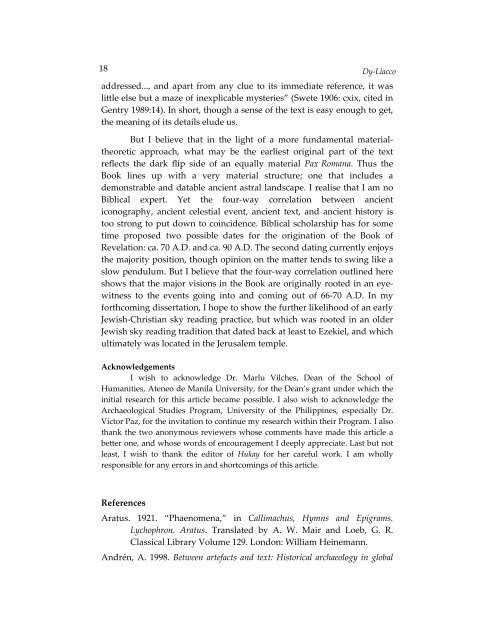18Dy-Liaccoaddressed..., and apart from any clue to its immediate reference, it waslittle else but a maze of inexplicable mysteries” (Swete 1906: cxix, cited inGentry 1989:14). In short, though a sense of the text is easy enough to get,the meaning of its details elude us.But I believe that in the light of a more fundamental materialtheoreticapproach, what may be the earliest original part of the textreflects the dark flip side of an equally material Pax Romana. Thus theBook lines up with a very material structure; one that includes ademonstrable and datable ancient astral landscape. I realise that I am noBiblical expert. Yet the four-way correlation between ancienticonography, ancient celestial event, ancient text, and ancient history istoo strong to put down to coincidence. Biblical scholarship has for sometime proposed two possible dates for the origination of the Book ofRevelation: ca. 70 A.D. and ca. 90 A.D. The second dating currently enjoysthe majority position, though opinion on the matter tends to swing like aslow pendulum. But I believe that the four-way correlation outlined hereshows that the major visions in the Book are originally rooted in an eyewitnessto the events going into and coming out of 66-70 A.D. In myforthcoming dissertation, I hope to show the further likelihood of an earlyJewish-Christian sky reading practice, but which was rooted in an olderJewish sky reading tradition that dated back at least to Ezekiel, and whichultimately was located in the Jerusalem temple.AcknowledgementsI wish to acknowledge Dr. Marlu Vilches, Dean of the School ofHumanities, Ateneo de Manila University, for the Dean’s grant under which theinitial research for this article became possible. I also wish to acknowledge theArchaeological Studies Program, University of the Philippines, especially Dr.Victor Paz, for the invitation to continue my research within their Program. I alsothank the two anonymous reviewers whose comments have made this article abetter one, and whose words of encouragement I deeply appreciate. Last but notleast, I wish to thank the editor of <strong>Hukay</strong> for her careful work. I am whollyresponsible for any errors in and shortcomings of this article.ReferencesAratus. 1921. “Phaenomena,” in Callimachus, Hymns and Epigrams.Lychophron. Aratus. Translated by A. W. Mair and Loeb, G. R.Classical Library Volume 129. London: William Heinemann.Andrén, A. 1998. Between artefacts and text: Historical archaeology in global
Comets, Cults, and Coins 19perspective. Translated by A. Crozier. New York: Plenum.Aveni, A. F. 2001. Skywatchers. Austin, TX: University of Texas Press.antiquitiesproject. 2011. In flickr.com Website. Accessed 28 November 2011from http://www.flickr.com/photos/antiquitiesproject/5906496802/.Ashmand, J. M. 1822. “Preface,” in Ptolemy’s Tetrabiblos, or Quadripartite:Being Four Books of the Influence of the Stars. Translated by J. M.Ashmand, pp. v-xxvii. London: Davis and Dickson.Bintliff, J. (ed.). 1991. The Annales School and Archaeology. London and NewYork: Leicester University Press.britishmuseum.org. 2011. In The British Museum Website. Accessed 28November 2011 from http://www.britishmuseum.org/.Charlesworth, J. H. 1977. Jewish Astrology in the Talmud,Pseudepigrapha, the Dead Sea Scrolls, and Early PalestinianSynagogues. Harvard Theological Review 70.3/4: 183-200.Confino, A. 1997. Collective Memory and Cultural History: Problems ofMethod. The American Historical Review 102.5: 1386-1403.Frankfort, H. 1934. Gods and Myths on Sargonid Seals. Iraq 1.1: 2-29.Frankfort, H. 1955. Stratified Cylinder Seals from the Diyala Region. OrientalInstitute Publications 72. Chicago: University of Chicago Press.Gentry, K. L. 1989. Before Jerusalem Fell: Dating the Book of Revelation. Tyler,TX: Institute for Christian Economics.Gosden, C. 2004. “Towards a theory of material engagement,” inRethinking materiality: The engagement of mind with the materialworld. Edited by E. DeMarrais et al., 33-40. Cambridge: McDonaldInstitute for Archaeological Research.Guskova, E. G., O. M. Raspopov, and V. A. Dergachev. 2010. Visualevidence of geomagnetic excursion? In St. Petersburg StateUniversity Earth’s Physics Department Website. Accessed 10 October2011 from http://geo.phys.spbu.ru/materials_of_a_conference_2010/P2010/Guskova_et_al_2010.pdf.Harris, R. 1991. Inanna-Ishtar as Paradox and a Coincidence of Opposites.History of Religions 30.3: 261-278.Hill, G. F. 1899. A Handbook of Greek and Roman Coins. London and NewYork: MacMillan.Jacobsen, T. 1976. The Treasures of Darkness: A History of MesopotamianReligion. Cambridge, MA: Harvard University Press.
- Page 2 and 3: Hukay is a Tagalog term that can ei
- Page 5 and 6: ContentsiForeword1 Comets, Cults, a
- Page 7 and 8: iForewordHukay Volume 17 contains f
- Page 9 and 10: Comets, Cults, and Coins:A material
- Page 11 and 12: Comets, Cults, and Coins 3the mater
- Page 13 and 14: Comets, Cults, and Coins 5questioni
- Page 15 and 16: Comets, Cults, and Coins 7historica
- Page 17 and 18: Comets, Cults, and Coins 9authority
- Page 19 and 20: Comets, Cults, and Coins 11arisen e
- Page 21 and 22: Comets, Cults, and Coins 13This bea
- Page 23 and 24: Comets, Cults, and Coins 15This clo
- Page 25: Comets, Cults, and Coins 17Figure 6
- Page 29: Comets, Cults, and Coins 21Rochberg
- Page 32 and 33: 24Guiebexploratory visit to Batasan
- Page 34 and 35: 26looks into how certain claims to
- Page 36 and 37: 28Guieblocated off northwestern Boh
- Page 38 and 39: 30 Guieb(PAWB 2004). The NIPAS Act
- Page 40 and 41: 32 Guiebwho come to their reef. The
- Page 42 and 43: 34 GuiebSayer (1995) argues that it
- Page 44 and 45: 36Guiebrest in this site)’ was ho
- Page 46 and 47: 38 Guiebisland, which is also calle
- Page 48 and 49: 40 Guiebof their marine environment
- Page 50 and 51: 42 Guiebestablishment of an MPA on
- Page 52 and 53: 44 Guiebconservation. Village-encod
- Page 54 and 55: 46 Guiebharvest. Regardless of econ
- Page 56 and 57: 48 GuiebIn Batasan, sites with perm
- Page 58 and 59: 50 Guiebcorrals vulnerable to theft
- Page 60 and 61: 52 Guiebecology of marine conservat
- Page 62 and 63: 54 GuiebDios. 2006. Coastal Environ
- Page 64 and 65: 56 Guieb1918 manuscript. Manila: Th
- Page 66 and 67: 58 GuiebUmali, A. F. 1950. Guide to
- Page 69 and 70: Determination of Oriental Tradeware
- Page 71 and 72: Determination of Oriental Tradeware
- Page 73 and 74: Determination of Oriental Tradeware
- Page 75 and 76: Determination of Oriental Tradeware
- Page 77 and 78:
Determination of Oriental Tradeware
- Page 79 and 80:
Determination of Oriental Tradeware
- Page 81 and 82:
Determination of Oriental Tradeware
- Page 83 and 84:
Determination of Oriental Tradeware
- Page 85 and 86:
Determination of Oriental Tradeware
- Page 87 and 88:
Microlithic Sites of Mandla (Madhya
- Page 89 and 90:
Microlithic Sites of Mandla 81compl
- Page 91 and 92:
Microlithic Sites of Mandla 83Sites
- Page 93 and 94:
Microlithic Sites of Mandla 85offer
- Page 95 and 96:
Microlithic Sites of Mandla 87Figur
- Page 97 and 98:
Microlithic Sites of Mandla 89Some
- Page 99 and 100:
Microlithic Sites of Mandla 91group
- Page 101 and 102:
Microlithic Sites of Mandla 93Figur
- Page 103 and 104:
Microlithic Sites of Mandla 95admin
- Page 105 and 106:
Microlithic Sites of Mandla 97Neoli
- Page 107 and 108:
Microlithic Sites of Mandla 99Histo
- Page 109 and 110:
Microlithic Sites of Mandla 101evol
- Page 111 and 112:
Microlithic Sites of Mandla 103preh
- Page 113 and 114:
Microlithic Sites of Mandla 105asso
- Page 115 and 116:
Microlithic Sites of Mandla 107iws.
- Page 117:
Microlithic Sites of Mandla 109www.
- Page 120 and 121:
112Eusebioacross Southeast Asia and
- Page 122 and 123:
114archaeologists do not publish in
- Page 124 and 125:
116different language family (Austr
- Page 126 and 127:
118Eusebiosubject is not even the f
- Page 128 and 129:
120Eusebiojournals, the topic gaine
- Page 130 and 131:
122Eusebio125:175-192.Dolukhanov, P
- Page 132 and 133:
124ParrenoSoares, P., J. A. Trejaut
- Page 134 and 135:
126made by the public. Quantifying
- Page 136 and 137:
128MelendresPhilippines, some are r
- Page 138 and 139:
130Manalochanges in the organisatio
- Page 140 and 141:
132Manalodefeat a giant, and marry
- Page 142 and 143:
134Santamariaborn,” and may refer
- Page 144 and 145:
136home, accompanied by bursts of f
- Page 146 and 147:
138Reyescognates of each other? Is
- Page 148 and 149:
140have used important Southeast As
- Page 150 and 151:
142ReferencesSteinberg, D. J. (ed.)
- Page 152 and 153:
144the law would protect a child ev
- Page 154 and 155:
Wills, J. E. Jr. 2011. China and Ma



